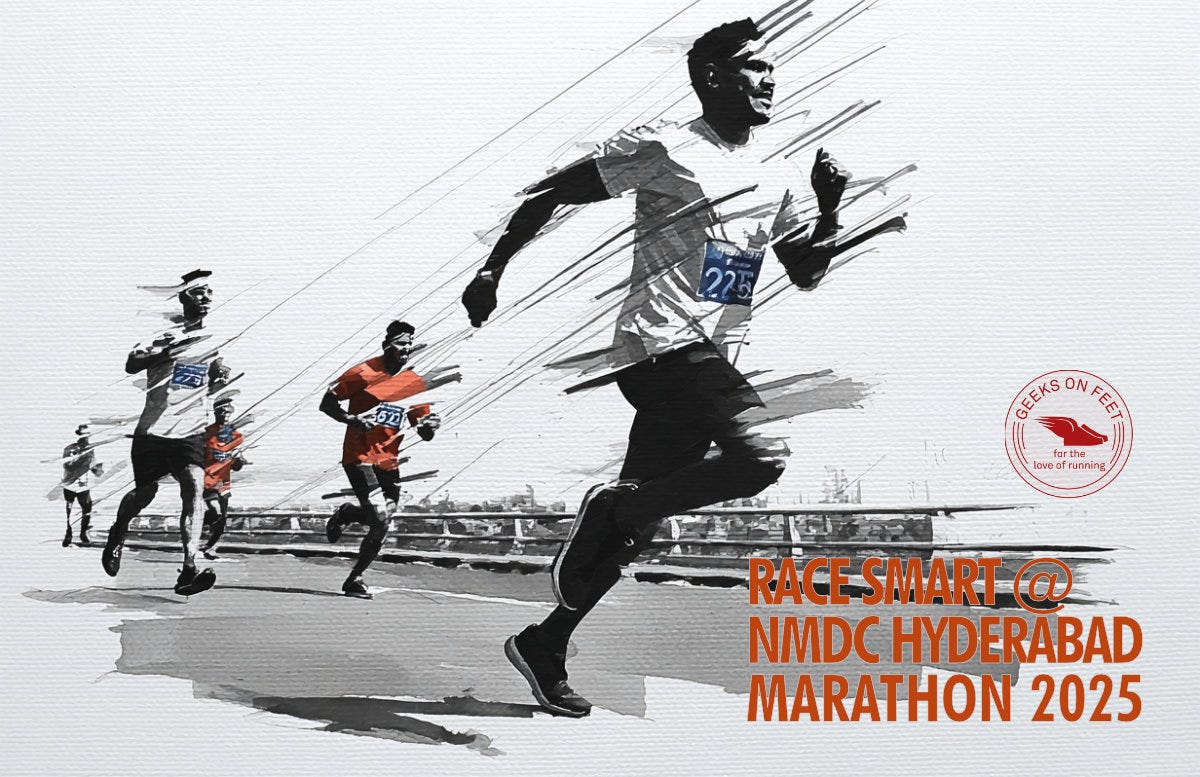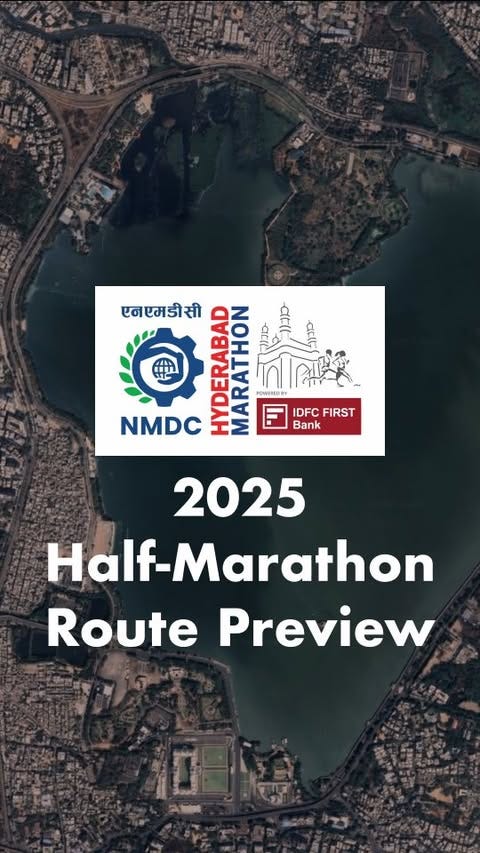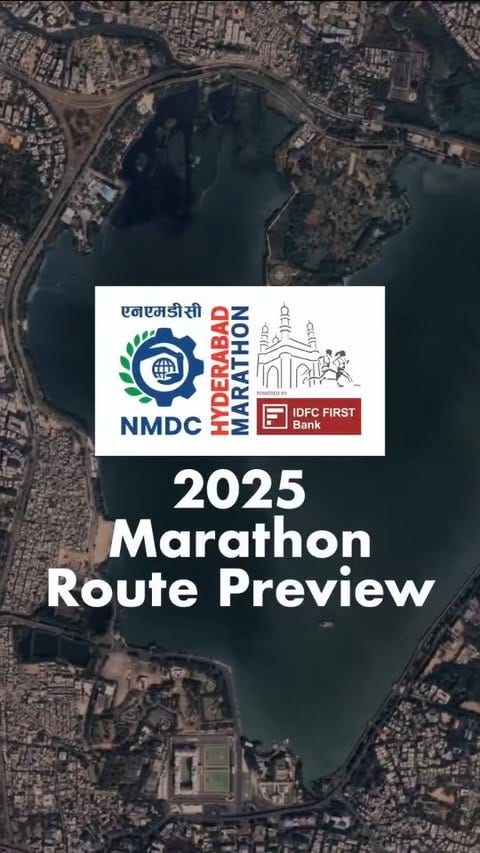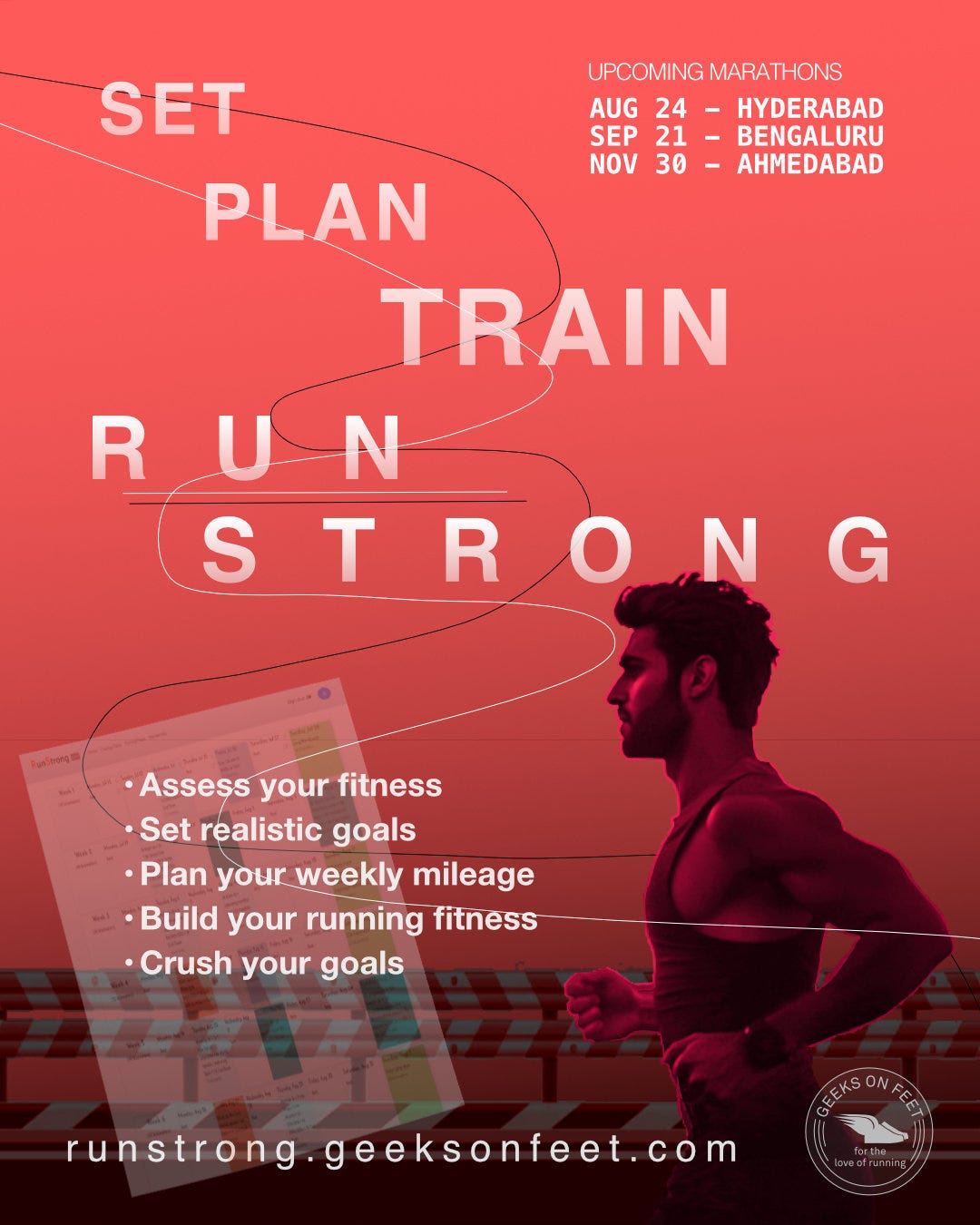Pace calculator for NMDC Hyderabad marathon, mobility drill, Chicago Marathon elite line-up & more!
#WhatsUpThisWeek?
A few calculators to help you race smart at the NMDC Hyderabad Marathon 2025, at #GeeksOnFeet.
The Groiner is a dynamic mobility drill that opens up the hips, groin, and hip flexors, improving stride length and efficiency, at #WoW
Korir and Alemu headline Chicago Marathon 2025 elite fields, this and more at #RunSHORTS
Planning to self-train for the upcoming season, we have prepared a self-paced training plan for you at #Runstrong. Whether a beginner or seasoned runner, this plan has something for everyone.
3K Pace Governor Strategy at #TipOfTheWeek
Happy Reading!
#GeeksPoll
If a race goes fully eco-friendly (green medals, no water bottles, no t-shirts, no race-kit goodies, sustainable logistics), would you run? #geekspoll
Answer Live Poll Here.
The results of last week's poll on what runners think of race illegal shoes are now out.
#WoW - Groiner
The Groiner is a dynamic mobility drill that opens up the hips, groin, and hip flexors, improving stride length and efficiency. It also activates the core and stabilizers, enhances ankle mobility, and prepares the body for injury-free running. Regular practice helps runners maintain better form and reduce the risk of strains.
How to do it?
Place your hands directly under your shoulders, body in a straight line from head to heels.
Bring your one foot forward and place it just outside the same hand.
Keep your back leg extended and hips low.
Sink slightly into the stretch, feeling it in your hip flexors, groin, and hamstrings.
You can gently press your hips toward the floor.
Step your foot back into the plank.
Repeat on the other side.
@GeeksOnFeet: Race Smart @ NMDC Hyderabad Marathon 2025
It’s the race week for the Hyderabad Marathon. Training is behind you, and all those long runs, hill repeats, and tempo sessions are done. Now it’s about sharpening the mind, calming the nerves, and having a solid plan for race day.
One of the big questions runners face this week is: What’s a realistic finish time for me on Hyderabad’s hilly course? And once that’s clear, how should I pace myself to get there?
We’ve put together a few calculators to help you race smart.
We’ve also put a short video of the route for the marathon and half-marathon distances.
Shakeout Run – NMDC Hyderabad Marathon 2025
Join us on 23rd Aug (Sat), 6:30 AM, opposite Telangana State Secretariat for a Shakeout Run. Ask us any questions on the Route or pacing. Miles, Smiles & Community Vibes!
RUN STRONG - Training Plans
Prepares you for the course evaluations
Personalised for your goals
Customised to your fitness
Can be planned per your schedules
Access the plans now at https://runstrong.geeksonfeet.com/training-plans/
#RunSHORTS:
Korir and Alemu headline Chicago Marathon 2025 elite fields
The Bank of America Chicago Marathon 2025 (12 October) will see defending champion John Korir and Valencia winner Megertu Alemu lead the elite fields.
Korir, who ran 2:02:44 last year, ran the second-fastest in race history, also enters as Boston Marathon champion and is aiming for a sub-2:01 performance, a mark only ever achieved by the late Kelvin Kiptum in Chicago (2023). He’ll face strong competition from Timothy Kiplagat (2:02:55), Amos Kipruto (2:03:13), Bashir Abdi, and half-marathon world record-holder Jacob Kiplimo. Conner Mantz leads the U.S. charge, chasing national and continental records.
On the women’s side, Ethiopia’s Megertu Alemu returns after her 2023 podium, boasting a 2:16:34 PB. She is joined by compatriots Hawi Feysa, Irine Cheptai, and marathon debutante Ejgayehu Taye, ensuring a deep, competitive field.
The 2025 edition promises another showcase of world-class marathon racing on Chicago’s fast course. Key Contenders to Watch:
Men
John Korir (KEN) – 2:02:44, defending champion
Timothy Kiplagat (KEN) – 2:02:55, Tokyo runner-up
Jacob Kiplimo (UGA) – HM world record-holder, London runner-up
Bashir Abdi (BEL) – 2x Olympic medalist
Conner Mantz (USA) – eyeing US & North American records
Women
Megertu Alemu (ETH) – 2:16:34, Valencia champion
Hawi Feysa (ETH) – 2:17:00, Frankfurt winner
Irine Cheptai (KEN) – 2:17:51, Chicago podium finisher
Ejgayehu Taye (ETH) – debut, 10,000m world bronze
Read more here.
Records Shattered at Leadville 100
At the high‑altitude Leadville Trail 100 Run, notorious for its grueling climbs over 12,600‑foot Hope Pass, David Roche (USA), 37, remarkably defended his championship title, crossing the finish line in 15:12:30, crushing the course record he set in 2024 by a whopping 14 minutes. The Boulder-based ultrarunner, paced over the final 23 miles by his wife and coach, Megan Roche, averaged a brutal 9:07 per mile even under extreme conditions. Roche, already the course record holder, delivered a dominant performance this summer despite a recent DNF at the Western States 100, a feat many in the ultrarunning community consider a redemption.
Meanwhile, in a stunning debut 100‑mile race, Anne Flower, a 35‑year‑old emergency room physician from Colorado Springs, ran 17:58:19, becoming the first woman to complete the Leadville Run in under 18 hours. She smashed the longstanding 1994 women’s course record set by Ann Trason, 18:06:24, by more than eight minutes. Flower, with no prior 100‑mile racing experience, showed exceptional strategy and composure, holding back early, fueling smartly, and unleashing a powerful finish to claim the historic win. Read more here
Kipyegon narrowly misses 3000m world record at Silesia Diamond League
Kenya’s Faith Kipyegon, fresh off lowering her own 1500m world record in June, came within a whisker of another historic mark at the Silesia Diamond League in Chorzow. The three-time Olympic champion clocked 8:07.04 over 3000m, just outside Wang Junxia’s long-standing world record of 8:06.11, set in 1993.
Wang’s record, part of a series of astonishing Chinese performances in the early 1990s, has long been surrounded by controversy and suspicion of state-sponsored doping, with even Wang later admitting to being coerced into such practices. Many in athletics regard it as one of the most “untouchable” records in women’s track.
Pacemakers Sage Hurta-Klecker and Jessica Hull set the early rhythm, but Hull stepped off with two and a half laps remaining, leaving Kipyegon to chase the mark alone. Despite a powerful push, she left herself too much to do on the final lap. Read more here.
Registration for the Tata Mumbai Marathon starts today
The registration for India's largest road running event, the Tata Mumbai Marathon, is expected to open today. The marathon attracts over 40,000 runners across multiple categories, including the Full Marathon, Half Marathon, 10K, Dream Run, Senior Citizen Run, and a Run for Champions with Disabilities.
Full Marathon: Registration opens today, 20 August 2025, and closes on 28 November 2025
Half Marathon: Registration begins on 25 August 2025 and closes on 10 September 2025
10K: Women's criteria registration begins on 28 August 2025 and closes on the same day
* Registration may close earlier than the mentioned dates once the places are filled
More details here
At RunMechanics, we have assessed 400+ runners. Click here to book your appointment
Race Calendar
Search and find races using our Race Finder at geeksonfeet.com/races.
#TipOfTheWeek: 3K Pace Governor Strategy
The biggest mistake even experienced runners make is trying to hit goal pace right from the start. But that probably is not the ideal strategy. Here is why?
Your heart rate is suppressed at the start due to adrenaline.
Your perceived effort is unreliable.
And your glycogen usage is most aggressive in those first 15–20 minutes.
So what do pros and smart racers do? They run the first 3 km at 95–97% of goal pace on purpose.
In long races (especially half and full marathons), the first 3 km should be a deliberate holding pattern, not a flying start. Think of it as a “pace governor” phase, you’re building into your rhythm, letting HR rise gradually, and keeping fuel burn efficient.
Backed by practice (and science):
Kenyan and Japanese elites are masters at this. Their opening 3 km are often slower than average pace, but they close harder because they never spike early. A 2014 study in the Journal of Strength and Conditioning Research found that negative split strategies correlated with better pacing efficiency and race outcomes, especially in endurance events.
How to apply it:
Say your goal pace is 5:00/km. Start at 5:10/km for 3 km, then lock into race pace. You’ll feel “too easy” at first. Perfect. That’s the trick. From 5 km onwards, let effort slowly climb, not spike. You’ll pass dozens of runners later who went out too hot, and your splits will be stronger in the latter half.
#TriviaOfTheWeek: Ensuring Fair Podiums!
Ever notice why bib colors differ across gender and race categories? BIB swapping in races is unfair, but pretty common globally. But claiming a podium finish with a swapped BIB? That's not easy. The race organisers rely on both technology and some manual efforts to make sure the podium calls into the right hands. Most swapping happens to qualify for bigger races that demand eligibility, like the Boston Marathon.
To prevent this, men and women often get different colors, while distances and age groups may have unique shades. Larger races in India, like the Tata Mumbai Marathon or the TCSW10K, even add a barcode on the bib that volunteers scan at the entry gate to verify runners. Some organisers go further and cross-check with race photographs post-race to confirm if the claimed winner ran. Such measures help race organisers finalise podium winners in a simple but effective way.
Support Us
Our mission is to empower the running community by providing valuable insights into all aspects of running. Through our weekly updates, we’ve been able to make a significant impact, reaching runners across India and beyond.
This wouldn’t be possible without the incredible support and feedback from our community. If you’ve found value in our work and appreciate our efforts, we kindly ask for your support through a donation. Your contribution will enable us to continue delivering high-quality content and help us make an even greater impact. Thank you for being an integral part of our journey!
Contributors to this edition: Aditi Pandya, Karthik Nadar, and Aravind Yarra









